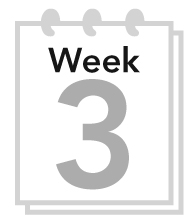
All that healthful eating we’ve been talking about starts with a good breakfast, so this week you’ll learn why it’s so important and how to put one together in no time. We’ll cover more tips to trim calories, build on your walking program, and make use of your food record.
Rush! Hurry! Go! There’s no time for breakfast!
Hey, not so fast! A little planning will help you get a balanced morning meal lickety-split. You may wonder why you should eat breakfast when you’re trying to lose weight. It’s simple; skipping meals causes people to overeat. Eating breakfast is a critical strategy for weight loss and the prevention of weight regain, though many who skip breakfast have the misguided notion that it saves them calories. Many of those who are certain that they are not eating more calories overall when they skip breakfast really are. Among participants in the National Weight Control Registry (NWCR)—a listing of thousands of people who have lost at least 30 pounds and kept if off for at least one year—78% eat breakfast every day. Additionally, eating breakfast is associated with healthier cholesterol levels, better insulin sensitivity, and greater intakes of several vitamins and minerals, including potassium, calcium, iron, and vitamin C.
If you’re worried that eating in the morning will raise your blood glucose, you’ll be delighted to see how eating may actually push those morning numbers down. Morning blood glucose levels are largely regulated by hormonal factors and the actions of your liver. While sleeping, your cells use up the glucose from your dinner or evening snack, so the liver sends more glucose into the blood. Often in type 2 diabetes, the liver doesn’t recognize that there is ample blood glucose available, so it sends more out. Eating a food with carbohydrate tells the liver that you are no longer fasting, so it stops releasing extra glucose.
Eating behavior expert Brian Wansink, Ph.D., author of Mindless Eating: Why We Eat More Than We Think We Eat (Bantam Dell, 2006), argues that on average Americans eat about 30–35% more than they think they do. Even the most aware individuals eat about 20% more than they realize. If you think you aren’t influenced by the size of a dish, you probably are, he says. When nutrition science professors and graduate students were given various sizes of ice cream scoops and bowls to serve themselves at a party, those with the larger dish served up to 127 more calories compared with those with the smaller dish. That amount increased further when they had both the larger dish and the larger scoop. Even students and professors who know lots about food and what they are eating can be misled!
If the size of a dish can trick you into eating more, it can also trick you into eating less. Apply this concept to all aspects of eating and drinking. Will it be more satisfying to eat a 4-ounce steak on a 12-inch dinner plate or on an 8-inch salad plate? On the bigger plate, the steak looks like a child’s serving. Pull out your small dishes and glasses or buy some attractive new ones. Use nothing larger than a 9-inch plate for dinner, 1-cup bowls for cereal, ½-cup dishes for ice cream and other desserts, and 1-ounce shot glasses for M & M’s, jellybeans, and the like.
For weight loss, blood glucose control, and overall fitness, you should engage in both cardiovascular (aerobic) and strength-training exercises. If you have any doubts about beginning an exercise program, or about cranking it up a notch if you’re already active, talk to your physician first. If you started walking last week or just started wearing a pedometer, keep it up this week and do a bit more, if possible. Our emphasis this week is on cardiovascular exercise. Walking, swimming, biking, stair climbing, dancing, and other activities that get you breathing heavily for several minutes strengthen your heart. This type of activity aids weight loss by burning calories, giving you a boost in energy (this is why being tired is a poor excuse not to exercise), improving triglyceride and cholesterol levels, increasing insulin sensitivity, and lowering blood glucose levels.
You may feel overwhelmed with the recommendation to engage in at least 150 minutes of cardiovascular activity weekly. If so, take it slowly. Any amount of activity is better than none. Thirty minutes is better than 20, and 20 minutes is better than 10. Set SMART goals for exercise, just as you do for dietary changes. Examine where you are, where you want to go, and make strategies to get there. The best activity to pick is the one you enjoy, and the best time to do it is the time that works for you. For example, if exercising before bed makes it hard to relax into a good slumber, you might be more consistent if you exercise before dinner. Be sure to pick an indoor activity for bad weather days as well.
During exercise, you should work hard enough to improve fitness, but not so hard to hurt yourself. Warm up for a few minutes with some slow walking and some gentle stretches before beginning your aerobic activity. Do something similar after your activity. Adjust your intensity up or down to hit the range you are aiming for. As your fitness improves, add either a few minutes to your exercise routine or pick up the intensity a bit. Listen to your body and follow the pace that’s right for you.
Rate Your Exercise
A useful tool to help you judge your exercise is the Borg Rate of Perceived Exertion (RPE) Scale. It helps you assess your level of effort. The Borg Scale ranges from 6 to 20. Generally, a rating between 12 and 14 indicates a moderate level of intensity.
Here’s how you use it: while doing physical activity, rate how you perceive your level of exertion. Consider how strenuous the exercise feels to you, including your sense of exertion, effort, and fatigue. Focus on your whole body’s level of exertion, not just on any one part of your body. Then, choose the number on the scale that best represents how you perceive your level of effort.
The Borg Scale runs from 6 (no exertion at all) to 20 (maximal exertion). A 9 is “very light” exertion, such as an easy, slow walk. At 13, the effort is “somewhat hard,” the work is tiring but you can keep going on. For 15, you’re working out pretty hard, and at 17, the physical activity is strenuous and tiring. When you get up to 19, it’s hard to consider keeping up this level of exertion for any length of time.
It’s important to try to honestly assess your exertion level. Don’t think about how difficult you think the activity should be. Just scan your body and fairly assess how hard it is working. Honest assessments will yield the best results. For more information, check out this website: www.cdc.gov/physicalactivity/everyone/measuring/exertion.html.
You’ve kept your food record for at least two weeks by now. Take some time to look at it carefully. What patterns do you see? Perhaps you’ve noticed that you eat mindlessly in front of the television or feel the need for sweets in the afternoon. Maybe you tend to take second and third helpings, even though you’ve had enough to eat. Do you eat too fast, without fully tasting your food? By monitoring your own behaviors and progress, you can identify problem areas and take note of the strategies that work for you and those that do not. Some people like to review their food record daily and to write notes about things they did well or not so well. Then, they set a goal for the next day. Other people prefer to reflect on their food records weekly. Do what you prefer and what works for you and put those SMART goal practices into action.
 I always thought I was too busy to eat breakfast, and I thought that skipping breakfast would mean less calories overall. But, that wasn’t true. Eating breakfast has helped me control my blood glucose better and has kept me from getting so hungry that I eat whatever is convenient. What’s really surprising is that I feel SO much better. Now I plan ahead to get my breakfast ready while I’m getting ready for work. I even keep some things in the freezer for days when I’m in a hurry. Eating regularly throughout the day is one of the best things I can do for myself.
I always thought I was too busy to eat breakfast, and I thought that skipping breakfast would mean less calories overall. But, that wasn’t true. Eating breakfast has helped me control my blood glucose better and has kept me from getting so hungry that I eat whatever is convenient. What’s really surprising is that I feel SO much better. Now I plan ahead to get my breakfast ready while I’m getting ready for work. I even keep some things in the freezer for days when I’m in a hurry. Eating regularly throughout the day is one of the best things I can do for myself. Exercise is a big part of my diabetes management and weight-loss plan. Sometimes when I’d exercise, though, my blood glucose would go too low, which forced me to take in extra carbs to push it back into my target range. Weight loss is difficult under any circumstances, but being forced to eat to keep my blood glucose up was making it a lot harder. I worked with a certified diabetes educator, who is also a registered dietitian, to help adjust my insulin dose, so my blood glucose wouldn’t go too low. That did the trick. By reducing my insulin, I was able to eat less, which reduced my calorie intake. Weight loss is definitely achievable with persistence.
Exercise is a big part of my diabetes management and weight-loss plan. Sometimes when I’d exercise, though, my blood glucose would go too low, which forced me to take in extra carbs to push it back into my target range. Weight loss is difficult under any circumstances, but being forced to eat to keep my blood glucose up was making it a lot harder. I worked with a certified diabetes educator, who is also a registered dietitian, to help adjust my insulin dose, so my blood glucose wouldn’t go too low. That did the trick. By reducing my insulin, I was able to eat less, which reduced my calorie intake. Weight loss is definitely achievable with persistence. I keep a food record with a computer program that calculates my intake of calories, fat, protein, and carbohydrates. This helps me see if I’m on track or falling away from my goals, and it helps me feel like I have some control. For example, if I see that I’m going to go over my calorie budget for the day, I can choose what to do. I can choose to eat different foods or eat less or hit the gym a bit harder to balance things out.
I keep a food record with a computer program that calculates my intake of calories, fat, protein, and carbohydrates. This helps me see if I’m on track or falling away from my goals, and it helps me feel like I have some control. For example, if I see that I’m going to go over my calorie budget for the day, I can choose what to do. I can choose to eat different foods or eat less or hit the gym a bit harder to balance things out.  Continue the following goals: ___________________________________________________________
Continue the following goals: ___________________________________________________________